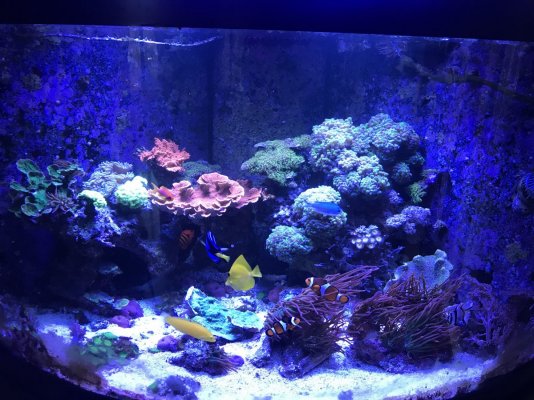- Joined
- Dec 7, 2018
- Messages
- 46
- Reaction score
- 31
I have a massive amount of vermatids and bristle worms to the point where I need to change the rocks and sand. There are so many vermatids, I usually cut up my hands without gloves. I also have a ton of flatworms- the ones that don't causes issues but are just unsightly and plan to take care of these last using many dips and might have to treat the tank after I get the amount of flatworms down as much as possible. I was removing a rock at a time letting it dry out to kill everything off then putting them back in but I can't keep up....
That being said- I have a very successful reef tank lol. Softies, LPS, SPS, anemones, spawning clownish, breeding nassarius snails and a very high fish load (feeding less is not really an option). Everything is very healthy and happy.
Unfortunately, I let the vermatids/bristle worms get out of control, breaking the vermatids off is not an option because there are just way too many. I'm afraid to touch anything because of all of the bristle worms- I do have a few arrow crabs but I would need a lot more. I understand bristle worms help clean up the waste but I have nassarius snails multiplying and I have hundreds of them. With such a high fish load I think I need to eliminate/minimize the bristle worms because there is just a lot of fish waste in general.
I pretty much automated the system which has allowed these issues to get out of hand. I monitor all the parameters- Calcium, Alkalinity, Magnesium, Phosphates and Nitrates. Aside from Ca, Alk, and Mg, I only add amino acids and trace elements. I have vodka being auto dosed which keeps my nitrates and phosphates down really low- sometimes too low. I recently added a lot more flow and a filter sock.
That being said my plan was to get new sand, new rock and cycle it in another container- I can seed it with a little sand from my current tank and maybe a piece of rock after I make sure there are no pests in it. Once, it cycles I am going to "feed it" like I would my main tank to build up the bacteria. Then clean out the main tank and replace everything.
I will manually remove the vermatids and bristle worms from the corals and the rocks with corals attached. Going forward- if I add any corals which I don't have much room, I will make sure they are dipped and manually remove anything else.
My other option is bringing back the bioballs (nitrates won't be an issue with my current dosing system) so when I swap out the rock/sand with the new cycled "heavily fed" sand/rock there is minimal chance of an ammonia spike. I don't think this will happen if I monitor the parameters of the cycling rock while I am adding food to it and don't see any ammonia spikes.
I am also open to any other advice you guys might have. My tank is doing great- it's just a mess and I don't want this to backfire. Thanks everyone for the help!
That being said- I have a very successful reef tank lol. Softies, LPS, SPS, anemones, spawning clownish, breeding nassarius snails and a very high fish load (feeding less is not really an option). Everything is very healthy and happy.
Unfortunately, I let the vermatids/bristle worms get out of control, breaking the vermatids off is not an option because there are just way too many. I'm afraid to touch anything because of all of the bristle worms- I do have a few arrow crabs but I would need a lot more. I understand bristle worms help clean up the waste but I have nassarius snails multiplying and I have hundreds of them. With such a high fish load I think I need to eliminate/minimize the bristle worms because there is just a lot of fish waste in general.
I pretty much automated the system which has allowed these issues to get out of hand. I monitor all the parameters- Calcium, Alkalinity, Magnesium, Phosphates and Nitrates. Aside from Ca, Alk, and Mg, I only add amino acids and trace elements. I have vodka being auto dosed which keeps my nitrates and phosphates down really low- sometimes too low. I recently added a lot more flow and a filter sock.
That being said my plan was to get new sand, new rock and cycle it in another container- I can seed it with a little sand from my current tank and maybe a piece of rock after I make sure there are no pests in it. Once, it cycles I am going to "feed it" like I would my main tank to build up the bacteria. Then clean out the main tank and replace everything.
I will manually remove the vermatids and bristle worms from the corals and the rocks with corals attached. Going forward- if I add any corals which I don't have much room, I will make sure they are dipped and manually remove anything else.
My other option is bringing back the bioballs (nitrates won't be an issue with my current dosing system) so when I swap out the rock/sand with the new cycled "heavily fed" sand/rock there is minimal chance of an ammonia spike. I don't think this will happen if I monitor the parameters of the cycling rock while I am adding food to it and don't see any ammonia spikes.
I am also open to any other advice you guys might have. My tank is doing great- it's just a mess and I don't want this to backfire. Thanks everyone for the help!

















